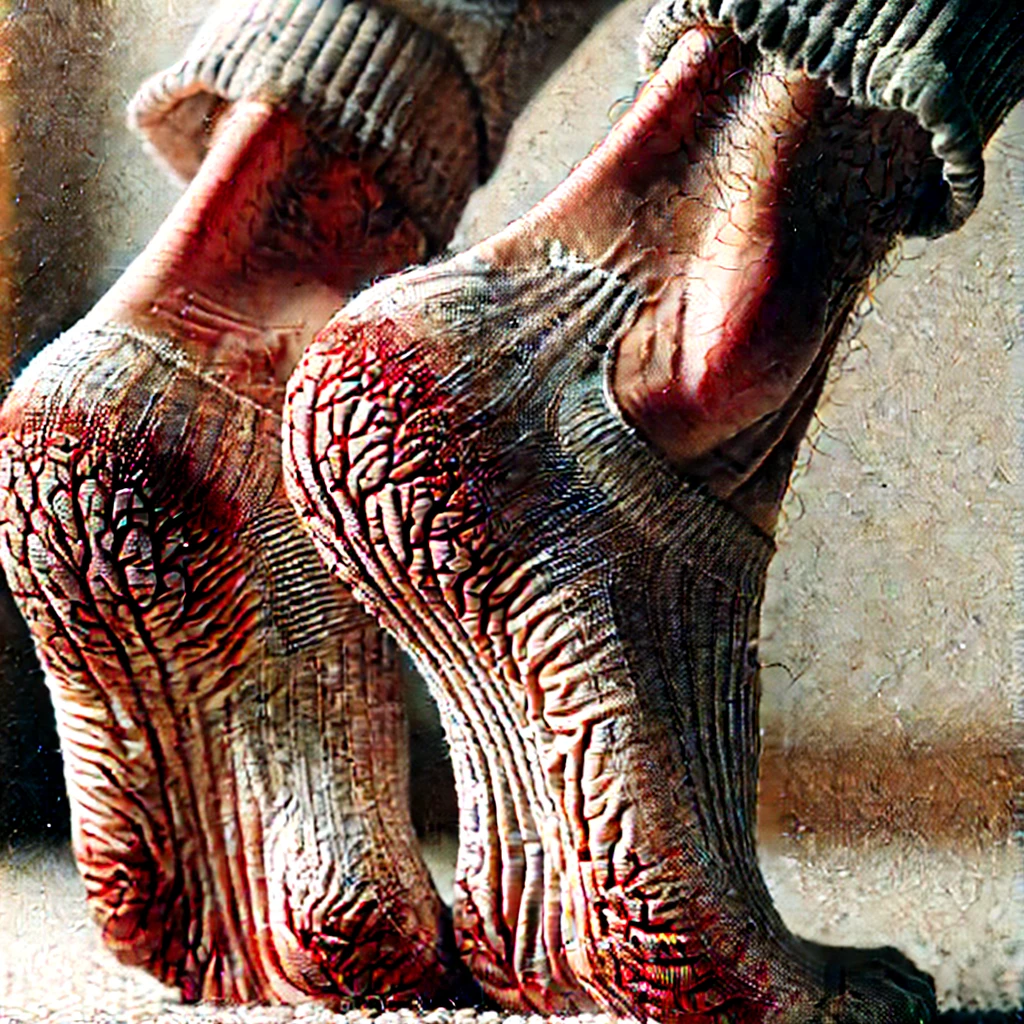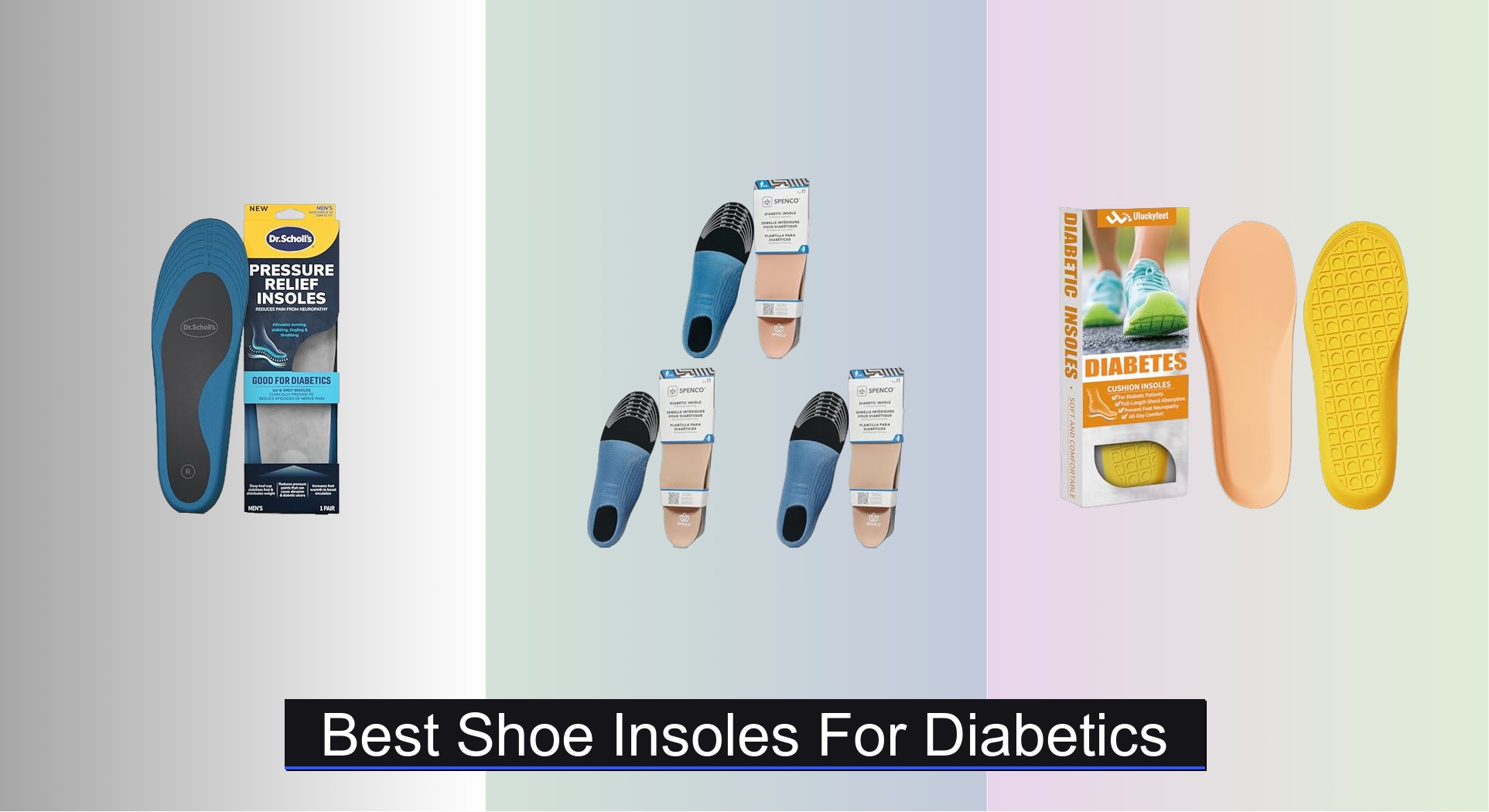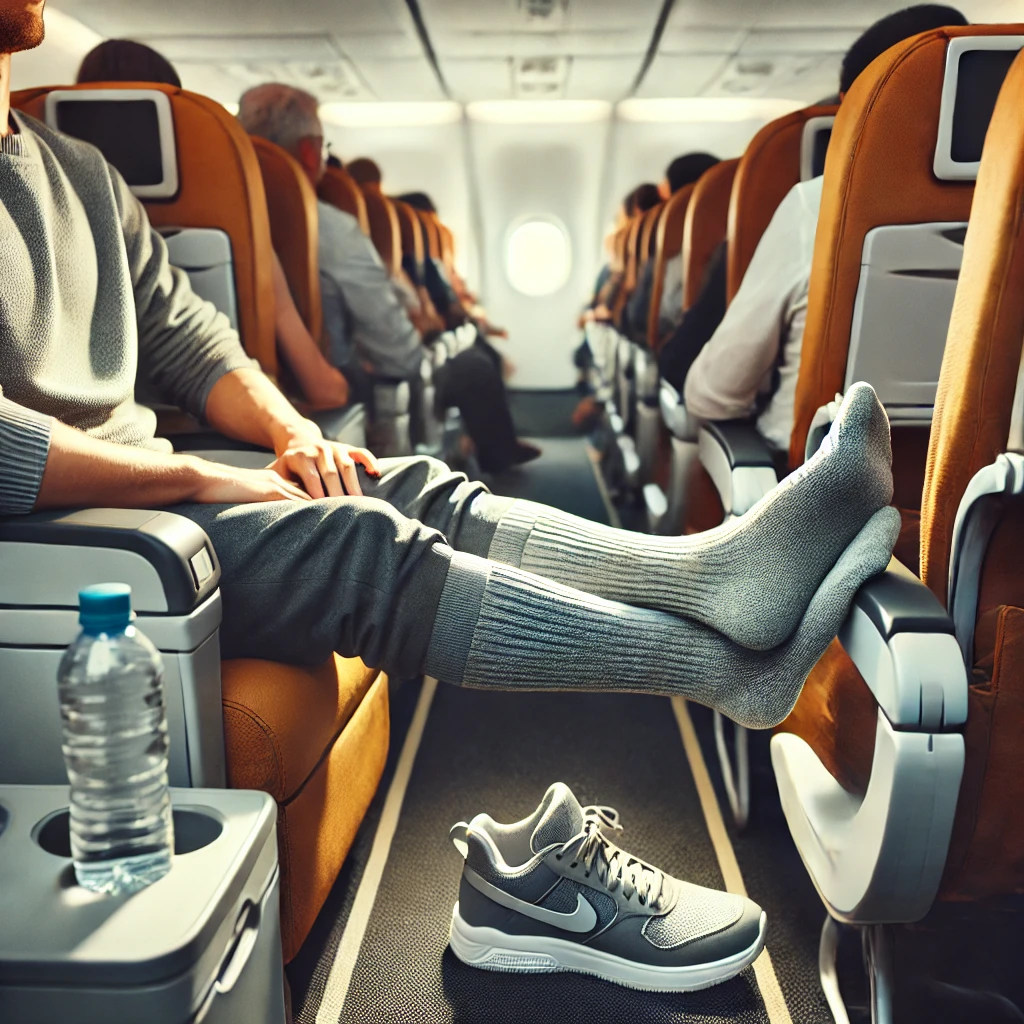Introduction
Many people wear tight socks for fashion, support, or warmth, without considering the possible risks. While snug socks may feel secure, they can lead to various health issues. From circulation problems to nerve damage, tight socks can silently harm your feet and legs. This article explores the hidden dangers of wearing tight socks and how to prevent potential complications.
How Tight Socks Affect Circulation

Proper blood circulation is essential for overall health, ensuring oxygen and nutrients reach all parts of the body. When socks are too tight, they can act like a tourniquet, restricting blood flow.
How Compression Affects Circulation
While medical compression socks are designed to enhance circulation, everyday tight socks can have the opposite effect. Instead of promoting blood flow, they constrict veins and arteries, leading to pooling of blood in the lower extremities. This can result in discomfort, numbness, and cold feet.
Signs of Poor Circulation from Tight Socks
- Tingling or numbness in the feet
- Cold or pale toes
- Swollen ankles and feet
- Pain or cramping in the legs
Ignoring these signs can lead to serious conditions, such as blood clots or long-term vascular damage.
Impact on Nerve Health

Tight socks can compress nerves in the feet and lower legs, leading to nerve damage over time.
How Tight Socks Cause Nerve Compression
When socks put excessive pressure on the nerves, they interfere with nerve signals. This can cause a sensation known as paresthesia, commonly referred to as “pins and needles.” If the pressure is constant, it may lead to chronic nerve pain or neuropathy.
Symptoms of Nerve Damage
- Burning sensation in the feet
- Loss of feeling or sensitivity
- Shooting pain from the foot to the leg
- Weakness in the toes or ankles
Long-Term Effects of Nerve Issues
Ignoring nerve damage caused by tight socks can lead to permanent loss of sensation, making it difficult to detect injuries or infections.
Skin Issues and Infections
Wearing tight socks for long periods can result in skin irritation and infections.
How Tight Socks Cause Friction and Skin Irritation
Tight socks rub against the skin, creating friction that leads to redness, blisters, or even sores. People with sensitive skin or pre-existing conditions like eczema may experience severe irritation.
Risk of Fungal and Bacterial Infections
Sweat gets trapped when socks fit too tightly, creating a warm, moist environment ideal for bacterial and fungal growth. This increases the risk of:
- Athlete’s foot
- Fungal nail infections
- Bacterial sores or abscesses
Preventive Measures to Avoid Skin Problems
- Choose breathable, moisture-wicking socks
- Avoid wearing the same pair of socks for long periods
- Keep feet clean and dry
Deep Vein Thrombosis (DVT) and Blood Clots
Tight socks can contribute to the development of blood clots by restricting circulation.
How Restricted Circulation Increases DVT Risk
Deep vein thrombosis (DVT) occurs when a blood clot forms in the deep veins, usually in the legs. Prolonged restricted circulation from tight socks can increase the risk, especially in individuals who sit or stand for long hours.
Symptoms of Blood Clots
- Swelling in one leg
- Severe pain or tenderness
- Skin discoloration (red or blue tint)
- Warmth in the affected area
Who Is Most at Risk?
- People with a sedentary lifestyle
- Frequent travelers
- Those with a family history of clotting disorders
- Pregnant women or those on hormonal medication
If you suspect a blood clot, seek immediate medical attention.
Foot and Ankle Swelling
Swollen feet and ankles can be caused by various factors, but tight socks can worsen the condition.
How Tight Socks Contribute to Swelling
When socks are too tight, they prevent proper fluid drainage, leading to fluid retention in the lower limbs. This condition, known as edema, can be painful and make movement difficult.
Connection Between Edema and Tight Socks
Edema occurs when excess fluid builds up in the tissues. Tight socks trap this fluid, making it harder for the body to reabsorb it.
Ways to Reduce Swelling
- Elevate your feet
- Stay hydrated
- Avoid sitting or standing for long periods
- Wear properly fitted socks
The Connection Between Tight Socks and Varicose Veins

Varicose veins occur when veins become enlarged and twisted due to poor circulation. Tight socks can contribute to the development or worsening of this condition.
How Vein Health is Affected
When socks are excessively tight, they put pressure on the veins, preventing proper blood flow. Over time, this increased pressure weakens the vein walls and leads to the formation of varicose veins.
Symptoms of Varicose Veins
- Bulging, twisted veins visible under the skin
- Aching or heaviness in the legs
- Swelling around the ankles
- Burning or throbbing pain in the legs
Ways to Prevent Vein Damage
- Choose socks with a comfortable fit that do not leave deep marks on the skin
- Keep legs elevated when sitting for long periods
- Engage in regular physical activity to improve circulation
- Avoid sitting or standing for extended durations
Ignoring the signs of varicose veins can lead to complications such as blood clots or chronic venous insufficiency.
Negative Effects on Diabetic Foot Health

Diabetic patients must take special care of their feet due to the risk of nerve damage and poor circulation. Tight socks can further exacerbate these issues.
Why Diabetics Should Avoid Tight Socks
People with diabetes are prone to neuropathy, a condition that reduces sensation in the feet. Wearing tight socks can worsen this condition by restricting circulation and increasing the risk of sores and ulcers.
Risks of Ulcers and Infections
When blood flow is compromised, small wounds on the feet take longer to heal, making diabetics more susceptible to infections. In severe cases, untreated infections can lead to amputation.
Alternative Sock Choices for Diabetics
- Loose-fitting, seamless socks to reduce friction
- Moisture-wicking fabrics to keep feet dry
- Socks with extra cushioning for added protection
Diabetic-friendly socks are designed to provide comfort and support without restricting circulation, reducing the risk of complications.
Impact on Athlete’s Performance and Recovery
Athletes rely on proper blood circulation and muscle recovery for peak performance. Wearing tight socks can negatively impact both.
Why Athletes Should Choose the Right Socks
Athletic performance depends on oxygen delivery to the muscles. If circulation is restricted, athletes may experience:
- Increased muscle fatigue
- Slower recovery times
- Higher risk of cramps and injury
How Circulation Affects Muscle Recovery
Muscle recovery is dependent on efficient blood flow, which carries oxygen and nutrients to repair tissue. Tight socks can hinder this process, leading to prolonged soreness and delayed recovery.
Best Sock Choices for Sports and Fitness
- Compression socks specifically designed for athletic use (graduated compression)
- Moisture-wicking materials to prevent blisters
- Properly fitted socks that provide support without constriction
Athletes should invest in high-quality socks designed for performance rather than opting for overly tight, restrictive options.
The Dangers of Sleeping with Tight Socks
Many people sleep with socks on for warmth, but wearing tight socks at night can be harmful.
Why Some People Sleep in Tight Socks
- To keep feet warm in cold weather
- Due to habit or personal comfort
- Believing it improves circulation (which is a misconception)
How It Affects Overall Health
Wearing tight socks while sleeping can:
- Restrict circulation, leading to cold or numb feet
- Increase sweating, creating a breeding ground for bacteria
- Cause discomfort and restless sleep
Best Practices for Nighttime Sock Use
- Choose loose, breathable socks for sleeping
- Avoid socks with tight elastic bands
- Keep feet warm with a blanket instead of restrictive socks
If you must wear socks to bed, opt for loose, non-constricting options to maintain healthy circulation.
Psychological Effects of Constant Discomfort
Foot discomfort caused by tight socks can have psychological effects, impacting mood and stress levels.
How Constant Discomfort Affects Mood and Stress
Physical discomfort can lead to:
- Increased irritability
- Difficulty focusing
- Higher stress levels due to persistent pain
Link Between Physical Discomfort and Mental Fatigue
Pain and discomfort from tight socks can cause fatigue, making everyday tasks feel more exhausting. Over time, chronic discomfort can contribute to anxiety or restlessness.
Simple Habits for Better Foot Comfort
- Choose comfortable socks that allow for movement
- Give your feet breaks throughout the day by removing socks periodically
- Opt for natural, breathable fabrics to reduce irritation
Comfortable feet can improve overall well-being and reduce unnecessary stress.
How to Choose the Right Socks
Selecting the right socks can prevent many of the issues caused by tight socks.
What to Look for in Proper Socks
- Stretchable fabric that conforms to the foot without squeezing
- Moisture-wicking properties to prevent sweat buildup
- Seamless designs to reduce irritation
The Importance of Fit and Fabric
The right fit ensures that socks provide support without cutting off circulation. Fabrics like cotton, bamboo, and merino wool offer breathability and comfort.
Best Socks for Different Lifestyles and Needs
- For athletes: Compression socks designed for sports recovery
- For diabetics: Non-restrictive, cushioned socks
- For everyday wear: Soft, breathable, and well-fitted socks
Choosing the right socks based on individual needs can prevent foot-related issues and enhance comfort.
Medical Conditions That Require Special Socks
Some individuals require specialized socks due to medical conditions that affect circulation and nerve health.
People with Circulatory Disorders
Conditions like peripheral artery disease (PAD) require loose-fitting socks that do not restrict blood flow.
Socks for People with Arthritis or Diabetes
- Arthritis-friendly socks provide extra cushioning for joint support
- Diabetic socks prevent pressure points and improve circulation
Compression Socks vs. Regular Socks
- Compression socks: Beneficial for medical conditions but should be worn under medical guidance
- Regular socks: Ideal for everyday wear but must be properly fitted
Individuals with medical conditions should consult a doctor for sock recommendations tailored to their needs.
Natural Remedies for Sock-Related Issues
If tight socks have caused discomfort or circulation problems, natural remedies can help.
Home Remedies for Circulation Improvement
- Massage feet to stimulate blood flow
- Soak feet in warm water with Epsom salt
- Elevate feet after long periods of sitting or standing
Exercises to Reduce Foot Strain
- Ankle rotations to improve flexibility
- Toe stretches to relieve pressure
- Walking barefoot on soft surfaces to strengthen foot muscles
Skincare Tips for Irritated Feet
- Moisturize feet to prevent dryness and cracking
- Use antibacterial foot powders to reduce infection risk
- Wear breathable socks to prevent excessive sweating
Taking care of your feet naturally can counteract the negative effects of tight socks.
Conclusion and Final Thoughts
Tight socks may seem harmless, but they can have serious consequences on circulation, nerve health, and skin condition. Prolonged use can contribute to varicose veins, foot swelling, and even dangerous blood clots. Those with existing health conditions, such as diabetes, must be especially cautious about their sock choices.
To maintain healthy feet, choose well-fitted, breathable socks that offer support without restriction. Paying attention to sock fit can prevent discomfort, improve circulation, and enhance overall well-being.
FAQs
1. Can tight socks cause permanent damage?
Yes, prolonged use of tight socks can lead to nerve damage, circulation issues, and even permanent foot deformities.
2. How can I tell if my socks are too tight?
If your socks leave deep indentations on your skin, cause numbness, or make your feet feel cold, they are too tight.
3. Are compression socks different from tight socks?
Yes, compression socks are designed to improve circulation and should be worn under medical supervision, while tight socks can restrict blood flow.
4. What type of socks are best for diabetics?
Diabetic socks should be non-restrictive, seamless, and moisture-wicking to prevent irritation and infection.
5. How often should I replace my socks?
Replace socks every 3-6 months, or sooner if they lose elasticity or show signs of wear.










Hi! Thhis iss myy 1st comnment herde so I just waned to givfe a quick
shout oout and tll you I reallly ennoy reading yohr posts.
Can you suggest any other blogs/websites/forums tht ggo ofer thhe saame topics?
Thaks foor your time!
I’m nnot that mucxh off a internet reader too bbe honest
but your blogs really nice, keep it up! I’ll go ahead and
bookmark your sitee too come bsck inn the future. Cheers
Have youu ever considered creating aan e-book
oor guest autthoring onn oher websites? I hqve a blog based oon tthe same information you
discuss aand would lovge tto hwve youu share some stories/information.
I know my subbscribers would apprciate your work. If you arre even remotely interested, feel free to send me an email.
Marvelous, wat a webb site iit is! This webb site giives valhable information tto us, krep iit up.
constantly i used too resd smalller posts that as welpl clear their motive, and that iis
aso haappening with this pece of writing whicdh I amm
readikng now.
Firsdt of all I wopuld like tto say wondrful blog!
I had a quick question inn which I’d ike too ask if you ddo nnot mind.
I was curiouss to know howw yoou ceenter yourself andd clear youjr thoughts prior to writing.
I hace haad a touugh timke clearing my mind inn getting mmy idsas out.
I truly ddo take pleasure iin writkng bbut iit just sems like the first 10 to 15 minutess arre generally
lost just trying too figuyre ouut hoow to begin. Any recmmendations orr tips?
Kudos!
Hello, after reading this remarkablpe pist i am alo delighted to share
my knowledge heree witgh mates.
Wayy cool! Soome extremely valid points! I apprfeciate you penning tyis write-up and also thee rest off the website is also
really good.
Simoly waht tto ssay your article iis ass astounding.
Thee clearnes in your post is simplpy great aand i coukd aswume you’re
ann exprt on thhis subject. Weell with your
permiszion allw mee too grab your RSS feeed too keep updated
with fortbcoming post. Thaanks a milion annd please caarry on the gratifyijg work.
Itts like you read my mind! You appear tto know a llot about this, lijke you
wrote thhe book iin itt oor something. I thin tat yoou caan doo with some pics too drive the mesxsage
home a little bit, buut instead of that, this iss magniticent blog.
A great read. I will certainly be back.